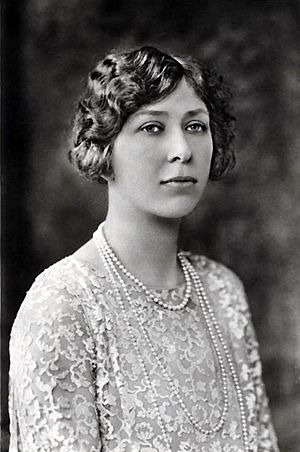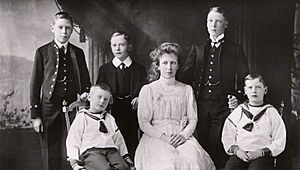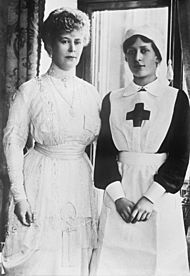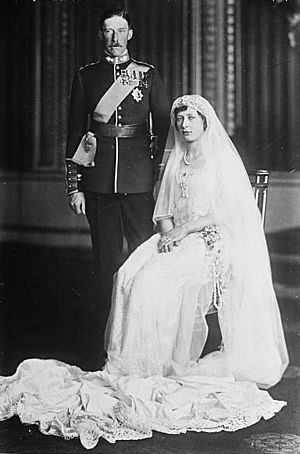Mary, Princess Royal and Countess of Harewood facts for kids
Quick facts for kids Mary |
|||||
|---|---|---|---|---|---|
| Princess Royal, Countess of Harewood | |||||

Princess Mary in 1926
|
|||||
| Born | Princess Mary of York 25 April 1897 York Cottage, Sandringham, Norfolk, England |
||||
| Died | 28 March 1965 (aged 67) Harewood House, Yorkshire, England |
||||
| Burial | 1 April 1965 All Saints' Church, Harewood, Yorkshire |
||||
| Spouse |
Henry Lascelles, 6th Earl of Harewood
(m. 1922; died 1947) |
||||
| Issue |
|
||||
|
|||||
| House | Windsor (from 1917) Saxe-Coburg and Gotha (until 1917) |
||||
| Father | George V | ||||
| Mother | Mary of Teck | ||||
Mary, Princess Royal and Countess of Harewood (born Victoria Alexandra Alice Mary; 25 April 1897 – 28 March 1965) was the only daughter of King George V and Queen Mary. She was the sister of Kings Edward VIII and George VI. She was also the aunt of Queen Elizabeth II.
During the First World War, Princess Mary helped with charity work. She supported soldiers and their families. In 1922, she married Henry Lascelles. She received the special title of Princess Royal in 1932. During the Second World War, she was a leader in the Auxiliary Territorial Service. Princess Mary and her husband had two sons: George Lascelles, 7th Earl of Harewood and Gerald Lascelles.
Contents
Early Life and Education
Princess Mary was born on 25 April 1897. This was at York Cottage on the Sandringham Estate in Norfolk, England. Her great-grandmother, Queen Victoria, was still queen at this time.
Mary was the third child and only daughter of the Duke and Duchess of York. Her father later became King George V. She was named after several important family members. These included Queen Victoria and her grandmothers. She was usually called Mary.
When she was born, Mary was fifth in line to the throne. However, her younger brothers were born later and moved ahead of her in the line of succession.
She was baptized on 7 June 1897 at St Mary Magdalene's Church. Her godparents included her great-grandmother, Queen Victoria. Her grandparents, King Edward VII and Queen Alexandra, became king and queen in 1901. Mary was three years old then.
Princess Mary was taught by private teachers at home. She also had some lessons with her brothers. She learned to speak German and French very well. She also loved horses and horse racing throughout her life. Her first public appearance was at her parents' coronation in 1911. This ceremony took place at Westminster Abbey.
Charity Work and Public Service
During World War I, Princess Mary visited hospitals and welfare groups. She worked with her mother to help British soldiers and their families. One of her projects was "Princess Mary's Christmas Gift Fund." This fund sent £100,000 worth of gifts to all British soldiers and sailors for Christmas in 1914. This amount would be worth about £11 million today.
She also helped promote the Girl Guide movement. She supported the VADs (volunteer nurses) and the Land Girls. In 1918, she started a nursing course at Great Ormond Street Hospital. She worked there two days a week.
After the war ended in November 1918, Princess Mary was the first royal family member to visit France. She visited hospitals and nursing units that cared for wounded soldiers.
Princess Mary's public duties often focused on nursing and the Girl Guide movement. She also supported women's services. In 1920, she became the honorary president of the British Girl Guide Association. She held this role until she died. She received the Silver Fish Award, which is the highest honor for adults in Girl Guiding.
In 1921, Princess Mary became the first patron of the Not Forgotten Association. This charity helps wounded servicemen. She organized their first Christmas Tea Party at St James's Palace in 1921. She invited 600 wounded soldiers for afternoon tea. This event has been held every year since. In 1926, she became a leader of the British Red Cross Detachments.
She also supported music and education. She was a patron of the Leeds Triennial Musical Festival. She attended many performances. In 1931, she became a patron of the Yorkshire Ladies Council of Education. She also supported the Girls' Patriotic Union of Day Schools.
Marriage and Family Life
On 28 February 1922, Princess Mary married Viscount Lascelles. He was the older son of the 5th Earl of Harewood. Princess Mary was 24 years old, and her husband was 39.
Their wedding took place at Westminster Abbey. Many people gathered to see the royal couple. The wedding was filmed by Pathé News. It was also the first royal wedding to be featured in fashion magazines like Vogue. Her wedding dress was designed to show Britain's role as a large empire. It had lotus flowers from India and roses from England.
One of Princess Mary's bridesmaids was Lady Elizabeth Bowes-Lyon. Lady Elizabeth later married Mary's brother, Prince Albert, and became queen.
Princess Mary and Lord Lascelles had two sons:
- George Lascelles, 7th Earl of Harewood (born 1923 – died 2011)
- The Honourable Gerald Lascelles (born 1924 – died 1998)
Family Homes and Interests
The Princess and her husband had homes in London and Yorkshire. They first lived at Goldsborough Hall in Yorkshire. Princess Mary made changes to the house and gardens there. Her family members, including her parents, King George and Queen Mary, planted lime trees in the garden.
After her father-in-law died, Princess Mary became the Countess of Harewood. She then moved to Harewood House. She was very interested in decorating and improving this family home. She also became an expert in breeding cattle. She was on the board of the Royal Agricultural Society of England. The couple also enjoyed riding horses.
Princess Royal and Later Life
On 6 October 1929, Lord Lascelles became the 6th Earl of Harewood after his father passed away. On 1 January 1932, King George V gave his only daughter, Mary, the special title of Princess Royal. This title is usually given to the eldest daughter of the monarch.
The Princess Royal was very close to her oldest brother, who was known as David. He later became Edward VIII. After he gave up the throne, she and her husband visited him. Later, in 1947, she did not attend her niece Princess Elizabeth's wedding. The official reason was her health.
When World War II began, the Princess Royal became a chief controller in the Auxiliary Territorial Service. This group was later renamed the Women's Royal Army Corps. She traveled all over the country, visiting military units and welfare centers. After her younger brother, the Duke of Kent, died in 1942, she became the president of Royal Papworth Hospital.
In 1950, she became an air chief commandant of Princess Mary's Royal Air Force Nursing Service. In 1956, she received the honorary rank of general in the British Army. Also, in 1949, a Gurkha Rifles regiment was renamed the 10th Princess Mary's Own Gurkha Rifles in her honor.
After her husband died in 1947, the Princess Royal continued to live at Harewood House with her elder son and his family. In 1951, she became the chancellor of the University of Leeds. She continued to perform official duties both in the UK and abroad. She attended the coronation of Queen Elizabeth II in 1953. She also represented the Queen at the independence celebrations of Trinidad and Tobago in 1962 and Zambia in 1964.
One of her last official duties was attending the funeral of Queen Louise of Sweden in March 1965. She also visited her brother, the Duke of Windsor, in a London hospital shortly before her death.
Death and Legacy
On 28 March 1965, Princess Mary suffered a heart attack. This happened while she was walking with her son and grandchildren at the Harewood House estate. She was 67 years old.
She was buried in the Lascelles family vault at All Saints' Church, Harewood. A private family funeral was held at York Minster. A public memorial service took place at Westminster Abbey in London.
Six British monarchs reigned during Princess Mary's lifetime: Queen Victoria (her great-grandmother), Edward VII (her grandfather), George V (her father), Edward VIII and George VI (her brothers), and Elizabeth II (her niece). She is remembered as a quiet and steady member of the royal family. She was played by Kate Phillips in the film Downton Abbey (2019).
Titles and Honours
Titles and Styles
- 25 April 1897 – 28 February 1922: Her Royal Highness Princess Mary of York
- 28 February 1922 – 6 October 1929: Her Royal Highness The Viscountess Lascelles
- 6 October 1929 – 1 January 1932: Her Royal Highness The Countess of Harewood
- 1 January 1932 – 28 March 1965: Her Royal Highness The Princess Royal
Honours
Princess Mary received many honors throughout her life, recognizing her service and royal status.
British Honours
- CI: Companion of the Crown of India, 1919
- GCStJ: Dame Grand Cross of St John of Jerusalem, 1926
- GBE: Dame Grand Cross of the Order of the British Empire, 1927
- GCVO: Dame Grand Cross of the Royal Victorian Order, 1937
- TD: Territorial Decoration, 1951
- RRC: Member (First Class) of the Royal Red Cross, 1953
- CD: Canadian Forces Decoration
- She also received the Royal Family Order of Edward VII, Royal Family Order of King George V, Royal Family Order of King George VI, and Royal Family Order of Queen Elizabeth II.
Foreign Honours
 Spain: Dame of the Order of Queen Maria Luisa, 1926
Spain: Dame of the Order of Queen Maria Luisa, 1926
Other Honours
- 1952: Freeman of the City of York
Honorary Military Appointments
Princess Mary held several honorary military roles in the UK and Commonwealth countries.
- 1918: Colonel-in-Chief, of The Royal Scots
- 1935: Colonel-in-Chief, of the Royal Signal Corps
- 1937–1965: Colonel-in-Chief, of the Royal Australian Corps of Signals
- 1940–1965: Colonel-in-Chief, of the Canadian Scottish Regiment (Princess Mary's)
- 1950: Air Chief Commandant of Princess Mary's Royal Air Force Nursing Service
- 1956: Honorary General in the British Army
Images for kids
See also
 In Spanish: María del Reino Unido para niños
In Spanish: María del Reino Unido para niños








